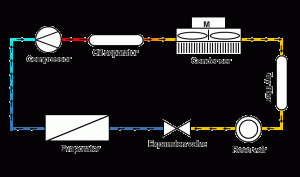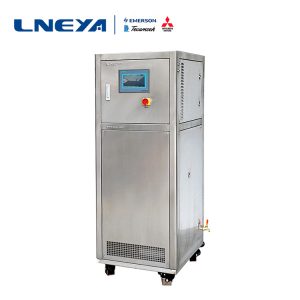Como reduzir a pressão de condensação da unidade de circulação do aquecimento?
During the operation of the heating circulator unit, the temperature change inside the equipment will cause the condensing pressure to change. Especially in summer when the condensing pressure is too high, the power consumption of the compressor will continue to increase, resulting in a gradual decrease in the cooling capacity, which indirectly makes the equipment cycle worse. It is necessary to appropriately reduce the condensing pressure.

1. Then, when the condensing pressure of the heating circulator unit is too low, the power supply of the throttle valve is insufficient, and the high-pressure liquid pipe is continuously affected by the heating factor, which will reduce the capacity of the throttle valve.
2. The pressure of the condenser can be controlled by adjusting the heat exchange capacity of the condenser. When the heat exchange of the condenser is large, the gas discharged from the compressor is fully condensed, and the condensing pressure gradually decreases; if the heat exchange performance of the condenser is weakened, the condensing pressure continues to rise.
3. The condenser can adjust the cooling water flow to control the condensation pressure. Install a regulating valve on the condenser cooling water outlet pipe. There are two modes for the water volume control valve: one is a temperature type water volume control valve that uses the temperature at the outlet of the cooling water of the condenser to indirectly send a letter. It has a temperature sensor that is inserted into the condensate outlet. When the water temperature rises, the valve opens large; when the water temperature decreases, the valve closes small. The other is a pressure-type water volume regulating valve that directly sends a signal from the condensing pressure, and the pressure signal is drawn from the condenser. When the condensing pressure gradually increases, the valve opens large; when the condensing pressure decreases, the valve closes small, thereby changing the cooling water flow of the condenser.
4. The self-contained cooling tower circulation system can be used. In order to prevent the condensation pressure from being too low, it can be adjusted by the water bypass valve, which makes part of the water from the condenser sent to the cooling tower for cooling, and the other part is returned to the bypass. water outlet.
For the LNEYA heating circulator unit, if multiple pumps are used in parallel, the number of running pumps can be changed to adjust the flow rate according to the constant change of the condensing pressure.
Recomendações relacionadas
-
Memory chip test equipment system program description
1755With the rapid development of the component industry, the memory chip test equipment has also made great progress. So, how much do users know about the memory chip test equipment? In order to simplify the test steps, reduce the complexity of the t...
Ver detalhes -
A unidade de arrefecimento de baixa temperatura - efeito de arrefecimento de 120 graus é fiável?
1913LNEYA é especializada na produção de unidades de resfriamento criogênico de fluido único, a faixa de temperatura de resfriamento é de -150 graus a -5 graus, que pode atender a diferentes requisitos de temperatura de resfriamento. Os produtos são amplamente utilizados em aplicações de baixa temperatu...
Ver detalhes -
Lista de classificação das câmaras de ensaio alternadas de arrefecimento e aquecimento a alta e baixa temperatura
1409When choosing the high and low temperature cooling heating alternating test chamber, the enterprise users must have a certain understanding of the ranking list of the high and low temperature cooling heating alternating test chambers on the market...
Ver detalhes -
Instruções de manutenção de instrumentos relacionados com dispositivos de alta e baixa temperatura
1661O meio líquido deve ser adicionado antes da utilização do dispositivo de circulação a alta e baixa temperatura. O meio líquido geralmente usa mais de 95% álcool, e o meio líquido não pode ser inferior à placa de trabalho 20mm. O dispositivo de circulação a alta e baixa temperatu...
Ver detalhes
 LNEYA Refrigeradores industriais Fabricante Fornecedor
LNEYA Refrigeradores industriais Fabricante Fornecedor












